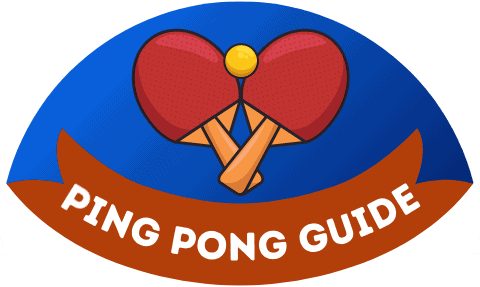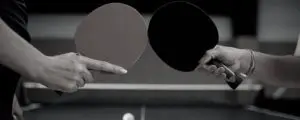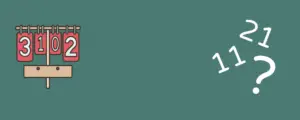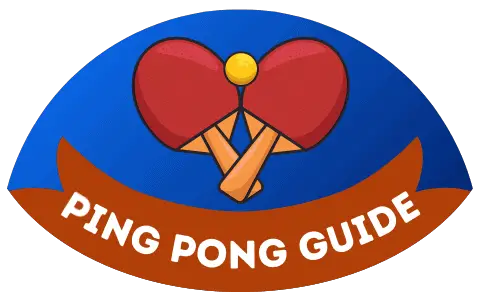I love table tennis because with a little practice you can play the ball back and forth quite comfortably. But that’s not enough for you and you want to improve? Great! In this post, you’ll find 17 great tips that will help you improve your level of play quickly.
The list
- 1. Move! Pay attention to your footwork
- 2. Copy the pros
- 3. Practice the basics
- 4. Use your whole body to hit the ball
- 5. Understand and read the spin of the ball
- 6. Counter spin with the right racket angle
- 7. Long balls are the key
- 8. Bring variation to your serves
- 9. Try to return serves flat
- 10. Test your opponent to find weaknesses
- 11. Don't mind training on your own
- 12. Play controlled and not too hard
- 13. Do not stand too close to the table.
- 14. Play with your weaknesses
- 15. Take your time
- 16. Try to think ahead
- 17. Always use the same racket
The 17 best tips for Ping Pong beginners
1. Move! Pay attention to your footwork
Even if your technique is not perfect yet, you can make things easier for yourself by always trying to stand correctly to the ball. If the ball is too close or too far from your body, it will be difficult for you to hit it in a controlled manner.
Therefore, try to be light on your feet and not stand rooted to the spot and move toward the ball. It is best to stand and move lightly on the balls of your feet.
Important: Try to take small steps to adjust your position to the ball perfectly. It does not always have to be big steps.
After you have hit the ball, you should return to the starting position in order to be prepared for the next stroke.
Starting position:
- Slightly bent your knees
- Feet about shoulder width apart
- Upper body slightly bent forward
- Arm approximately at right angle
- forearm length away from the table
2. Copy the pros
Everyone has seen a table tennis match. If you want to get better, it is really important to pay close attention. There is no one you can learn as much from as the table tennis pros with all their experience.
- How do they move?
- What does their stance look like?
- When do they place the ball where?
- How do they play forehand and backhand?
- And so on…
It may sound trivial, but you learn from the best. Especially if you try to practice the movements yourself.
3. Practice the basics
I think this tip can be written into any beginner’s tip list – no matter if it’s table tennis, sailing or model making. But it is true! For every beginner, the first goal should be to master the basics of the discipline. So what does that mean in terms of table tennis?
I am referring primarily to the basic strokes. The most important are:
- Push: In the push or push ball, the racket face points upward. This gives the ball backspin. Typically, the push is played above the plate.
- Drive: With the drive, the club is slightly tilted forward. This gives the ball a slight topspin.
Try to master those two techniques on your forehand and backhand. You can learn a lot from the pros, as mentioned in point 2. After that, it is time to practice, practice, practice…
4. Use your whole body to hit the ball
In table tennis, the striking motion does not come exclusively from the arms, but from the entire upper body (hips, arms, shoulders). By shifting your weight from one foot to the other, you can hit the ball more powerfully and put better pressure on your opponents.
5. Understand and read the spin of the ball
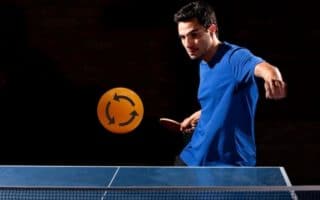
In table tennis, it is important to be able to read and understand the trajectory and spin of the ball. Only if you can do this, will you be able to use the right technique in the right situation and adjust the angle of the racket.
There are 3 different types of spin:
- Topspin – rotation to the front
- Backspin – rotation to the rear
- Sidespin – rotation to the side
And how do you actually know which spin a ball has?
There is a rule of thumb. Always watch your opponent closely and pay attention to the movement and tilt of his racket:
- If it moves from bottom to top and is tilted forward, then the ball has topspin
- If it moves from top to bottom and the racket is pointing upwards, the ball has backspin
- If the racket moves from one side to the other, the ball has sidespin
Important: Especially against good opponents, the rule of thumb may not apply completely. It is common to confuse your opponent with deceptions and feints.
Here is a great example from Adam Bobrow:
6. Counter spin with the right racket angle
There also is a simple rule of thumb for countering spin: Mirror your opponent. That means:
- If he plays topspin, you tilt the racket forward. Then, depending on the hardness of the ball, you can either respond with topspin yourself or simply block it.
- If he plays backspin, you should tilt your racket backwards so that the face of the racket is facing upwards and also answer with backspin.
- If he plays sidespin, tilt the racket in the opposite direction.
Of course, you can also return a topspin ball with backspin and so on. However, technique-wise, this is a bit more difficult, so you can stick to the upper rule of thumb for the time being.
7. Long balls are the key
With long balls, you put your opponent under better pressure. If the topspin ball bounces just before the baseline, there is less time for your opponent to react. If it hits the plate just behind the net, the ball travels longer from contact with the table to your opponent and he can return it more easily and dangerously.
Info: With backspin balls, it can be very advantageous to play a short ball that also stops due to the spin.
8. Bring variation to your serves
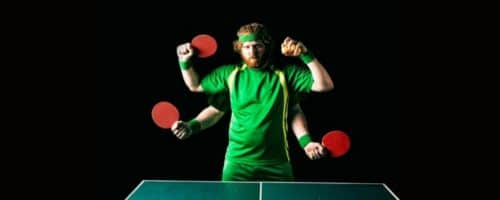
The serve gives you the opportunity to put your opponent under pressure early on and force him to make mistakes or hit high balls. One thing is important: Variety.
If you always play the same topspin serve on your opponent’s backhand, he will eventually adjust to it. That’s why it’s important to vary.
This is what you can mix:
- Serve with the forehand or backhand
- Spin: topspin, backspin, sidespin or no spin
- Direction: longline, center or cross
You should have at least 3 different serves in your repertoire to start with. But of course, the more the better.
9. Try to return serves flat
Now you are on the other side and your opponent serves. What should you pay attention to? In order to return your opponent’s serves without him being able to attack easily, it is important that you try to return the balls low over the net.
Often the push serves as a suitable technique for the return.
10. Test your opponent to find weaknesses
To win, it is important to exploit your opponent’s weaknesses. To do this, however, you have to find them first. Vary your strokes and pay close attention to his reaction:
- Does he play more backhand or forehand?
- Does he have problems with spin?
- How does he move? Does he stand still a lot?
Use the first few balls to test this. If you find a weakness, you can use it to your advantage: For example, you play more on the weak backhand instead of the forehand.
11. Don’t mind training on your own
If you want to get better, it should not stop you if you have no one to play against. Because a lot of things in table tennis can be trained perfectly well on your own.
There are a few ways you can play table tennis alone. For some you need additional equipment, like catch nets, robots, return boards or spin trainers. But you can also train your serve, improve your technique with shadow training or sharpen your accuracy with trick shots. If your own board allows it, the playback mode is also a good option.
You can read more about this in this article: How to play table tennis alone? 8 great tips for you!
12. Play controlled and not too hard
It is important that you do not play too hard and with too much force at the beginning. The technique should be in the foreground at first. If this is right, you can gradually increase your power.
If you go for hardness too early, you will often hit the balls uncontrollably into the net or out of bounds. The first goal should be to be able to hit the ball with control from all positions.
This will also give you advantages in the game: Having the option to just put the ball on the plate and gamble on an opponent’s mistake is always very helpful – especially in close and nerve-wracking matches.
13. Do not stand too close to the table.
As explained above, you should stand about a forearm’s length away from the table when playing table tennis. This has the advantage that you have more time to react. If you stand closer to the table, it will be difficult to return very long balls, for example.
In addition, the freedom of movement is limited by the table, which can restrict you, for example, when switching between forehand and backhand. For instance, balls coming directly at you can become a bigger problem when you are standing directly at the table. To avoid this, you should stand 1-2 steps behind the table.
14. Play with your weaknesses
Everyone has certain weaknesses and strengths. Normally, you tend to avoid your weaknesses and play to your strengths as much as possible. For example, if you prefer to play forehand rather than backhand, chances are that during practice and in the game you will rather walk around the ball to hit it with the forehand than simply take the backhand.
Unfortunately, this leads to the fact that you do not really improve the things you are bad at. Therefore it is important that you consciously train your weaknesses and practice them in the game instead of avoiding them. This is the only way you will improve them and yourself.
15. Take your time
Do you tend to lose your nerves in a tight game? Do you get hectic and make easy mistakes? Then take some time between the points and take a deep breath. Use this time to collect yourself.
If things are not going so well at the moment, this really helps you to regain your rhythm. This may sound trivial, but that’s exactly what professionals do.
For example, it’s one of the reasons why they keep going to the net and wipe their hand over the board during the game.
16. Try to think ahead

Table tennis is a physically demanding sport, but much is decided in the mind. During the rally, try to think about where your opponent’s next ball will go.
How can you get him to put pressure on you so that he plays a high ball that you can smash? – For example.
At the same time, thinking ahead is also important to anticipate where the ball will go before your opponent hits it. Then you can move accordingly in advance.
17. Always use the same racket
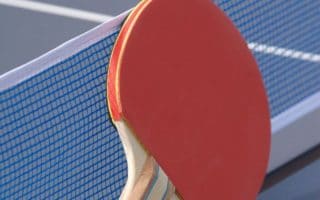
Different table tennis rackets can really have extremely different characteristics. If you keep playing with different paddles, it will be hard for you to constantly work on your technique, because you will always have to get used to the other new racket first.
Especially as a beginner, it’s really important to always play with the same racket. For the beginning, I would recommend a solid all-round racket. This has the advantage that you don’t get used to extreme paddle characteristics like excessive speed or spin.
Conclusion: Practice creates (ping pong) masters
Yes, the saying sounds corny, but it’s true: To get better, you have to practice, practice, practice. I hope you were able to take something from this article for your training. You will notice that you will quickly see success and increase your level of play.
But it is important to me that you do not forget one thing: The fun of the game 🏓
